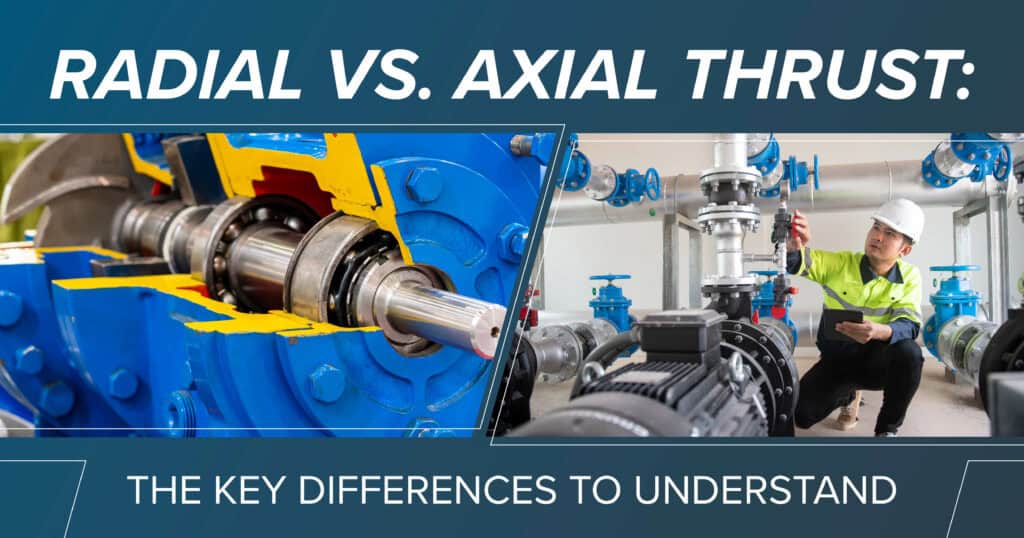In systems, understanding the forces at play is crucial. Monitoring and managing these key factors can enable you to maintain efficiency, prevent failures, and prolong equipment life. Two critical forces that every pump operator and engineer must grasp are radial thrust and axial thrust. These forces have a direct effect on your pump’s performance and maintenance needs. Here’s a closer look at what radial and axial thrust are, their key differences, and why understanding them is essential.
WHAT IS RADIAL THRUST?
Radial thrust is a force that acts perpendicular to the pump shaft. It arises when there’s an imbalance in pressure distribution around the pump’s volute, especially in single-volute designs. This force pushes outward from the center of the shaft, putting uneven stress on bearings and other components.
For instance, a single-volute pump operating far from its best efficiency point (BEP) may experience significant radial thrust. This can lead to excess vibration and wear. While double-volute designs can minimize this force, radial thrust remains a concern for pumps operating under variable conditions.
WHAT IS AXIAL THRUST?
Axial thrust, on the other hand, acts parallel to the pump shaft. This force is usually caused by pressure differences between the suction side and the discharge side of the pump. In many centrifugal pumps, the impeller design directly influences axial thrust.
A pump with an unbalanced impeller may experience substantial axial thrust, leading to excessive strain on thrust bearings. Pumps handling high flow rates or fluids with varying viscosities are particularly susceptible to this force.
CAUSES AND EFFECTS OF RADIAL AND AXIAL THRUST
Understanding the causes of radial and axial thrust is essential to diagnose issues and optimize pump performance.
Radial thrust often arises in single-volute pumps due to uneven pressure distribution. Hydraulic imbalances, cavitation, or operating at off-design conditions can exacerbate this force. Left unchecked, radial thrust can lead to:
- Accelerated wear on radial bearings.
- Misalignment of the pump shaft.
- Increased vibration, potentially resulting in seal or coupling failures.
Impeller design and operating conditions of the pump commonly cause axial thrust. Pumps operating far from their BEP or handling high discharge pressures are particularly vulnerable. The impacts of axial thrust include:
- Excessive wear on thrust bearings.
- Reduced overall efficiency and reliability.
- Shortened pump lifespan as a result of mechanical stress.
WHY UNDERSTANDING THE DIFFERENCE MATTERS
For pump operators and engineers, differentiating between radial and axial thrust is not theoretical—it’s practical. First, accurately predicting these forces is vital during pump design. Properly balancing radial and axial forces ensures smoother operation and reduces wear and tear. For operators, understanding these forces helps prevent costly failures, such as bearing or seal replacements.
Furthermore, matching pump designs to specific applications can significantly improve efficiency. For example, double-volute designs are better at minimizing radial thrust. Meanwhile, back-to-back impeller configurations can offset axial thrust. Informed decisions lead to fewer breakdowns and lower maintenance costs, directly affecting operational budgets.
SOLUTIONS AND BEST PRACTICES TO MANAGE THRUST FORCES
Proper management of radial and axial thrust involves both design considerations and operational best practices.
REDUCE RADIAL THRUST
- Use Double-Volute Designs. These designs balance pressure more effectively than single-volute designs, reducing radial forces.
- Monitor Operating Conditions. Avoid running pumps far from their BEP to prevent hydraulic imbalances.
- Address Cavitation. Regular maintenance can detect and eliminate cavitation, a common cause of radial thrust.
MITIGATE AXIAL THRUST
- Balance Impellers. Using impellers with balance holes or back-to-back configurations can minimize axial forces.
- Install Thrust Bearings. High-load-capacity bearings are critical to absorb axial thrust in demanding applications.
- Optimize for BEP. Operating as close as possible to the pump’s BEP reduces axial stress.
MAINTENANCE AND MONITORING THRUST FORCES
Regular maintenance and predictive monitoring are essential. By catching issues early, operators can prevent small forces from escalating into significant failures. Consultation with pump experts also ensures your system is optimized for its specific application, whether it’s handling high flow rates or abrasive materials.
Radial and axial thrust are fundamental forces that directly influence the efficiency, reliability, and lifespan of pump systems. By understanding the causes and effects of these forces, operators and engineers can make informed decisions to optimize performance and reduce costs.
Whether you’re selecting a new pump or troubleshooting an existing system, addressing radial and axial thrust should be a top priority. Contact DXP Pacific today to learn more about how we can help you manage these forces and ensure your pump systems operate at peak efficiency.

